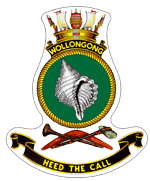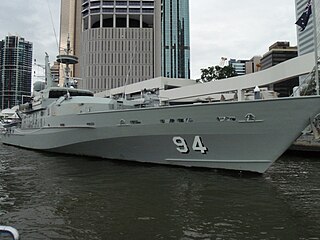
The Armidale class is a class of patrol boats built for the Royal Australian Navy (RAN). Planning for a class of vessels to replace the fifteen Fremantle-class patrol boats began in 1993 as a joint project with the Royal Malaysian Navy, but was cancelled when Malaysia pulled out of the process. The project was reopened in 1999 under the designation SEA 1444, with the RAN as the sole participant. Of the seven proposals tendered, the Austal/Defence Maritime Services (DMS) proposal for twelve vessels based on an enlarged Bay-class patrol boat was selected. Two additional boats were ordered in 2005 to provide a dedicated patrol force for the North West Shelf Venture.

HMAS Huon, named for the Huon River, is the lead ship of the Huon class of minehunters operated by the Royal Australian Navy (RAN). The first of six ships built by a joint partnership of Australian Defence Industries (ADI) and Intermarine SpA, Huon's hull was fabricated at Intermarine's Italian shipyard, then freighted to ADI facilities at Newcastle for completion. She entered service in 1999.

HMAS Armidale, named for the city of Armidale, New South Wales, is the lead ship of the Armidale class of patrol boats serving in the Royal Australian Navy (RAN). It was commissioned in June 2005 and decommissioned in March 2023.

HMAS Larrakia is an Armidale-class patrol boat of the Royal Australian Navy (RAN).

HMAS Bathurst, named for the city of Bathurst, New South Wales, is an Armidale class patrol boat of the Royal Australian Navy (RAN).

HMAS Albany, named for the city of Albany, Western Australia, is an Armidale-class patrol boat of the Royal Australian Navy (RAN).

HMAS Pirie, named for the city of Port Pirie, South Australia, is an Armidale-class patrol boat of the Royal Australian Navy (RAN).

The Leeuwin class is a two-ship class of hydrographic survey vessels operated by the Royal Australian Navy (RAN). Leeuwin and Melville were ordered from NQEA Australia in 1996, and were commissioned in 2000. The ships are capable of charting waters up to 6,000 metres (20,000 ft) deep, carry three Fantome-class survey boats, and could operate an AS 350B Squirrel helicopter. In addition to surveying duties, since 2001 both vessels have been used to supplement the RAN patrol force. Leeuwin and Melville are based at HMAS Cairns, and are active as of 2023.

PBAT Sentinel, formerly HMAS Maitland, named for the city of Maitland, New South Wales, is an Armidale-class patrol boat of the Royal Australian Navy (RAN).

HMAS Ararat, named for the town of Ararat, Victoria, was an Armidale-class patrol boat of the Royal Australian Navy (RAN).

HMAS Broome, named for the city of Broome, Western Australia, is an Armidale-class patrol boat of the Royal Australian Navy (RAN).

HMAS Bundaberg, named after the city of Bundaberg, was an Armidale class patrol boat of the Royal Australian Navy (RAN). The ship was built in Henderson, Western Australia, and was commissioned into the RAN in March 2007. Based at HMAS Cairns, Bundaberg spent much of her career deployed as part of border protection and fisheries protection patrols as part of Operation Resolute. In addition, the patrol boat was involved in several national and multinational training exercises, visited Vanuatu in 2011, tracked a suspected drug-smuggling vessel that led to a multimillion-dollar seizure, and participated in the International Fleet Review 2013. In August 2014, a large fire broke out on the ship while she was undergoing refit. Extensive damage from the fire led to the ship's decommissioning in December 2014.

HMAS Wollongong, named for the city of Wollongong, was an Armidale-class patrol boat of the Royal Australian Navy (RAN).

HMAS Childers is an Armidale-class patrol boat of the Royal Australian Navy (RAN). Named for the towns of Childers, Queensland and Childers, Victoria, Childers is the only ship in the RAN to be named after two towns.

HMAS Launceston is an Armidale-class patrol boat of the Royal Australian Navy (RAN).

HMAS Maryborough, named after the city of Maryborough, Queensland, is one of fourteen Armidale-class patrol boats operated by the Royal Australian Navy (RAN).
TRV Tuna (801) was one of three Torpedo Recovery Vessels operated by the Royal Australian Navy (RAN) and Defence Maritime Services (DMS). Ordered in 1969, the vessel, originally identified as TRV 253, was completed in 1970 and assigned to the torpedo firing range at Jervis Bay. The ship received a name and the pennant number "TRV 801" in 1983. In 1988, the three vessels were sold to DMS. Tuna was assigned to the naval base at HMAS Creswell in Jervis Bay. Tuna was active in DMS service as of 2007.
TRV Tailor (803) was one of three Torpedo Recovery Vessels operated by the Royal Australian Navy (RAN) and Defence Maritime Services (DMS). Ordered in 1969, the vessel, originally identified as TRV 255, was completed in 1971 and assigned to the naval base HMAS Waterhen in Sydney. The ship received a name and the pennant number "TRV 803" in 1983. In 1988, the three vessels were sold to DMS. Tailor was assigned to the naval base HMAS Creswell in Western Australia. Tailor was decommissioned in 2018.
The Fish class was a ship class of three torpedo recovery vessels previously operated by Defence Maritime Services (DMS).













